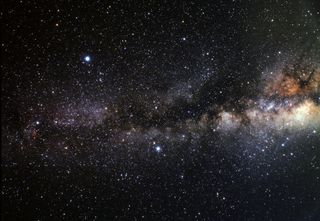View the 'Summer Triangle' and Its Bright Stars This Week

The famous "Summer Triangle" will appear overhead around 9:30 p.m. local time this week. The summer sky landmark is not a constellation itself, but rather three bright stars from three separate constellations. The pattern is nearly isosceles, which means it appears as a triangle with two equal-length sides.
Brightest of the three is the bluish-white Vega, in the constellation of Lyra, the Lyre. Next in brightness is the yellowish-white Altair in Aquila, the Eagle. Finally, there is white Deneb in Cygnus, the Swan. To our eyes, Vega appears twice as bright as Altair and more than three times brighter than Deneb.
Apparent brightness can be deceiving, however, and regarding actual luminosity a different tale is told: brilliant Vega is 40 times brighter than our sun and 25 light-years away. Altair is 10 times brighter than the sun and is one of our nearer neighbors at just 17 light years away; it owes its splendor in the summer skies to its nearness to the Earth. But Deneb is one of the greatest supergiant stars known. Its luminosity is nearly 200,000 times that of the sun, yet at 2,600 light-years away it appears to us as a fairly conspicuous but by no means particularly notable star. But if it were somehow possible to move Deneb to Vega's distance from us, it would then appear to shine some 40 times brighter than Venus, capable of casting distinct shadows and even being visible in the daytime.[Morning Milky Way Shines Over Summer Triangle in Stunning Photo]
A special treat of the Summer Triangle's noticeable prominence in summer months is the visible framing of the Milky Way between Vega and Altair. Deneb appears to lie in the middle of the Milky Way's dim band.

A symbol of the summer . . . or fall?
Although "Summer" Triangle suggests that it's a star pattern most favorably situated during the warm summer months, that is not entirely true. During July, it is visible during the entire night. By the time we get into September — a transitional month where we officially move into fall in the Northern Hemisphere — the Triangle continues to stand high overhead soon after darkness has fallen. To this end, some might argue that it should really be branded as the "Autumn" Triangle. However, on the day of the autumnal equinox, the Triangle has already begun to disappear below the west-northwest horizon by the break of dawn. So, unlike during the sultry nights of July, the Triangle does not remain in view from sunrise to sunset as the leaves begin to turn. But even as late as mid-November, stargazers can still see the Triangle in pretty much the same position that we would see it this week during the middle to late evening hours, though by mid-autumn this view will more closely correspond to dusk (around 5 p.m. local time).
Who branded it first?
There is some debate as to who first christened the bright stellar trio of Vega, Deneb and Altair as the Summer Triangle. Some say that the legendary British astronomer, Sir Patrick Moore (1923-2012), was the first to coin the term.
Noted Moore: "During a 1958 television broadcast on the BBC, I introduced the nickname of the Summer Triangle and everyone now seems to use the term, even though it is completely unofficial." However, several years earlier, in 1954, in his popular sky guide "Find the Constellations," H.A. Rey (1898-1977) also used the Summer Triangle moniker. Still others believe that the term was popularized through U.S. navigator training manuals during World War II. Interestingly, Romanian astronomer Oswald Thomas (1882-1963) described Vega, Altair and Deneb as "Grosses Dreieck" (Great Triangle) in the late 1920s and "Sommerliches Dreieck" (Summerly Triangle) in 1934.
Get the Space.com Newsletter
Breaking space news, the latest updates on rocket launches, skywatching events and more!
Joe Rao serves as an instructor and guest lecturer at New York's Hayden Planetarium. He writes about astronomy for Natural History magazine, the Farmers' Almanac and other publications, and he is also an on-camera meteorologist for Fios1 News in Rye Brook, New York. Follow us @Spacedotcom, Facebook and Google+. Original article on Space.com.
Join our Space Forums to keep talking space on the latest missions, night sky and more! And if you have a news tip, correction or comment, let us know at: community@space.com.

Joe Rao is Space.com's skywatching columnist, as well as a veteran meteorologist and eclipse chaser who also serves as an instructor and guest lecturer at New York's Hayden Planetarium. He writes about astronomy for Natural History magazine, the Farmers' Almanac and other publications. Joe is an 8-time Emmy-nominated meteorologist who served the Putnam Valley region of New York for over 21 years. You can find him on Twitter and YouTube tracking lunar and solar eclipses, meteor showers and more. To find out Joe's latest project, visit him on Twitter.
